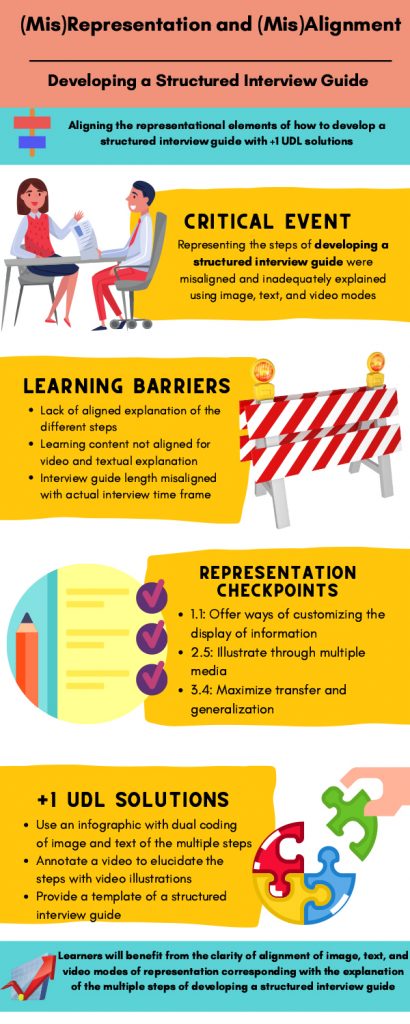Misrepresentation and Misalignment: Developing a Structured Interview Guide with +1 UDL Representation Solutions
By Rob LeGary, Jr., Director, Master of Education Program and Assistant Professor, Goodwin University
One of the challenges I encountered in the Effective Classroom Environments course in Goodwin University’s M.Ed. program is how to most effectively represent the guidelines and expectations for the assignments throughout the course. After reviewing the course assignments and the learning content that presents those assignments, I started to focus on one particular assignment and how it was presented to the students.
The learning barriers involved a formative assessment, the peer-to-peer structured interview guide, that progressively informs the second structured interview assignment with community teacher participants. I focused on the misalignment and inadequate explanation of the steps for how to develop a structured interview guide using image, text, and video modes. The presentation of content using multiple modes of representation were not aligned or clearly explained to facilitate learner understanding of the multiple steps of developing a structured interview guide.
This interview guide is used for their peer-teacher structured interview assignment focused on UDL principles and strategies. Some of the learning barriers were: (a) the lack of aligned explanation of the different steps for developing a structured interview guide, (b) learning content was not aligned for video and textual explanation, and (c) the interview guide length misaligned with the actual interview time frame. Importantly, learners were not adequately prepared with the content that explained the multi-step process of developing a structured interview guide for the in-class cooperative learning activity.
The UDL Representation Checkpoints addressed in this learning session were Checkpoint 1.1: Offer ways of customizing the display of information, Checkpoint 2.5: Illustrate through multiple media, and Checkpoint 3.4: Maximize transfer and generalization. These UDL Checkpoints all focus on the clarity and alignment of the different modes of representation when explaining a multi-step learning task that involves progressive preparation and implementation components of a particular activity. In this case, developing and following a structured interview guide.
Some of the +1 UDL Solutions for Representation with this particular learning activity aligned, of course, with the aforementioned UDL Representation Checkpoints. The first UDL Solution was to use an infographic with dual coding of image and text of the multiple steps of developing a structured interview guide. For example, using the Canva app to create the infographic.
The second UDL Solution involved the annotation of an instructional video that outlined the steps of developing a structured interview guide. This could be accomplished using applications such as EdPuzzle, a Doodle video, or Screencast. This annotated video provided clear and corresponding explanation of those illustrations of the different steps of creating a structured interview guide. Specifically, Blame (2016) explains that scaffolding techniques, such as signaling and weeding, can cue students to pertinent concepts while removing or deemphasizing extraneous information in a particular instructional video. This +1 UDLS leverages the effectiveness of a short, focused, and aligned instructional video with the key guidelines and steps for developing an interview guide.
The third UDL Solution relates to the transferability and generalization of this learning activity of developing a structured interview guide. That is, the provision of a template of a structured interview guide—consistent with those steps explained during this learning activity—would assist learners with more independence when developing structured interview guides for other interview assignments, especially for future courses like the Capstone.
Overall, learners will benefit from the clarity of alignment of image, text, and video modes of representation when learning and applying the multiple steps for developing a structured interview guide with independence and efficacy. They will understand and appreciate the steps of developing an interview guide with aligned imagery and text for those explanatory steps that they can access and comprehend more independently. Additionally, learners will benefit from the clarity and reinforcement provided by the alignment of annotations with video illustrations in detailing the steps of creating an interview guide. And, finally, learners will be able to apply and generalize more independently the steps of developing an interview guide for other structured interview assignments in the current course and beyond.

References
Blame, C.J. (2016). Effective educational videos: Principles and guidelines for maximizing student learning from video content. CBE—Life Sciences Education, 15(4), 1-6.
Goodwin University is recognized for its expertise in the application of the Universal Design for Learning framework to the design of learning experiences across a variety of learners and settings. Click here to learn more about Goodwin’s commitment to UDL and the resources that are available to educators.
Robert LeGary Jr. is director of the Master of Education program and an assistant professor at Goodwin University. He earned his doctorate in education from the University of Hartford and holds a master’s degree from Stony Brook University. For the past 20 years, Rob has served as a school administrator in the special education field. His practice and research have focused on students with autism spectrum disorder. Rob has taught and developed a variety of courses at Goodwin University since 2016 prior to joining the full-time faculty.

